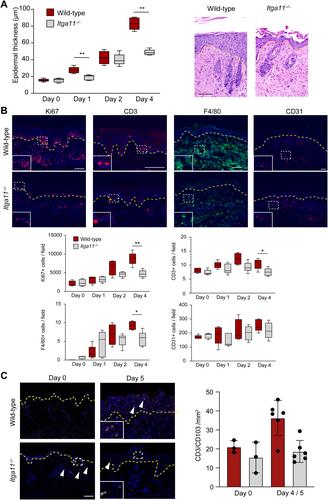Forward genetics and functional analysis highlight Itga11 as a modulator of murine psoriasiform dermatitis
Katja Bieber, Siegfried Bezdek, Yask Gupta, Artem Vorobyev, Tanya Sezin, Natalie Gross, Jasper Prüssmann, Jean-Paul Sayegh, Mareike Becker, Sadegh Mousavi, Ashref Hdnah, Sven Künzel, Saleh M Ibrahim, Ralf J Ludwig, Donald Gullberg, Christian D Sadik
下载PDF
{"title":"Forward genetics and functional analysis highlight Itga11 as a modulator of murine psoriasiform dermatitis","authors":"Katja Bieber, Siegfried Bezdek, Yask Gupta, Artem Vorobyev, Tanya Sezin, Natalie Gross, Jasper Prüssmann, Jean-Paul Sayegh, Mareike Becker, Sadegh Mousavi, Ashref Hdnah, Sven Künzel, Saleh M Ibrahim, Ralf J Ludwig, Donald Gullberg, Christian D Sadik","doi":"10.1002/path.6162","DOIUrl":null,"url":null,"abstract":"<p>Psoriasis is a chronic inflammatory skin condition. Repeated epicutaneous application of Aldara® (imiquimod) cream results in psoriasiform dermatitis in mice. The Aldara®-induced psoriasiform dermatitis (AIPD) mouse model has been used to examine the pathogenesis of psoriasis. Here, we used a forward genetics approach in which we compared AIPD that developed in 13 different inbred mouse strains to identify genes and pathways that modulated disease severity. Among our primary results, we found that the severity of AIPD differed substantially between different strains of inbred mice and that these variations were associated with polymorphisms in <i>Itga11</i>. The <i>Itga11</i> gene encodes the integrin α11 subunit that heterodimerizes with the integrin β1 subunit to form integrin α11β1. Less information is available about the function of ITGA11 in skin inflammation; however, a role in the regulation of cutaneous wound healing, specifically the development of dermal fibrosis, has been described. Experiments performed with <i>Itga11</i> gene-deleted (<i>Itga11</i><sup><i>−/−</i></sup>) mice revealed that the integrin α11 subunit contributes substantially to the clinical phenotype as well as the histopathological and molecular findings associated with skin inflammation characteristic of AIPD. Although the skin transcriptomes of <i>Itga11</i><sup>−/−</sup> and WT mice do not differ from one another under physiological conditions, distinct transcriptomes emerge in these strains in response to the induction of AIPD. Most of the differentially expressed genes contributed to extracellular matrix organization, immune system, and metabolism of lipids pathways. Consistent with these findings, we detected a reduced number of fibroblasts and inflammatory cells, including macrophages, T cells, and tissue-resident memory T cells in skin samples from <i>Itga11</i><sup>−/−</sup> mice in response to AIPD induction. Collectively, our results reveal that <i>Itga11</i> plays a critical role in promoting skin inflammation in AIPD and thus might be targeted for the development of novel therapeutics for psoriasiform skin conditions. © 2023 The Authors. <i>The Journal of Pathology</i> published by John Wiley & Sons Ltd on behalf of The Pathological Society of Great Britain and Ireland.</p>","PeriodicalId":232,"journal":{"name":"The Journal of Pathology","volume":"261 2","pages":"184-197"},"PeriodicalIF":5.6000,"publicationDate":"2023-08-11","publicationTypes":"Journal Article","fieldsOfStudy":null,"isOpenAccess":false,"openAccessPdf":"https://onlinelibrary.wiley.com/doi/epdf/10.1002/path.6162","citationCount":"0","resultStr":null,"platform":"Semanticscholar","paperid":null,"PeriodicalName":"The Journal of Pathology","FirstCategoryId":"3","ListUrlMain":"https://onlinelibrary.wiley.com/doi/10.1002/path.6162","RegionNum":2,"RegionCategory":"医学","ArticlePicture":[],"TitleCN":null,"AbstractTextCN":null,"PMCID":null,"EPubDate":"","PubModel":"","JCR":"Q1","JCRName":"ONCOLOGY","Score":null,"Total":0}
引用次数: 0
引用
批量引用
Abstract
Psoriasis is a chronic inflammatory skin condition. Repeated epicutaneous application of Aldara® (imiquimod) cream results in psoriasiform dermatitis in mice. The Aldara®-induced psoriasiform dermatitis (AIPD) mouse model has been used to examine the pathogenesis of psoriasis. Here, we used a forward genetics approach in which we compared AIPD that developed in 13 different inbred mouse strains to identify genes and pathways that modulated disease severity. Among our primary results, we found that the severity of AIPD differed substantially between different strains of inbred mice and that these variations were associated with polymorphisms in Itga11 . The Itga11 gene encodes the integrin α11 subunit that heterodimerizes with the integrin β1 subunit to form integrin α11β1. Less information is available about the function of ITGA11 in skin inflammation; however, a role in the regulation of cutaneous wound healing, specifically the development of dermal fibrosis, has been described. Experiments performed with Itga11 gene-deleted (Itga11 −/− Itga11 −/− and WT mice do not differ from one another under physiological conditions, distinct transcriptomes emerge in these strains in response to the induction of AIPD. Most of the differentially expressed genes contributed to extracellular matrix organization, immune system, and metabolism of lipids pathways. Consistent with these findings, we detected a reduced number of fibroblasts and inflammatory cells, including macrophages, T cells, and tissue-resident memory T cells in skin samples from Itga11 −/− mice in response to AIPD induction. Collectively, our results reveal that Itga11 plays a critical role in promoting skin inflammation in AIPD and thus might be targeted for the development of novel therapeutics for psoriasiform skin conditions. © 2023 The Authors. The Journal of Pathology published by John Wiley & Sons Ltd on behalf of The Pathological Society of Great Britain and Ireland.
正向遗传学和功能分析表明Itga11是小鼠银屑病样皮炎的调节剂
银屑病是一种慢性炎症性皮肤病。反复经皮施用Aldara®(咪喹莫特)乳膏会导致小鼠银屑病样皮炎。Aldara®诱导的银屑病样皮炎(AIPD)小鼠模型已用于检测银屑病的发病机制。在这里,我们使用了一种正向遗传学方法,在该方法中,我们比较了在13种不同的近交系小鼠品系中产生的AIPD,以确定调节疾病严重程度的基因和途径。在我们的主要结果中,我们发现不同品系的近交系小鼠之间AIPD的严重程度有很大差异,这些变化与Itga11的多态性有关。Itga11基因编码整合素α11亚基,该亚基与整合素β1亚基异二聚形成整合素α11β1。关于ITGA11在皮肤炎症中的作用的信息较少;然而,已经描述了在皮肤伤口愈合的调节中的作用,特别是在真皮纤维化的发展中。用Itga11基因缺失(Itga11−/-)小鼠进行的实验表明,整合素α11亚基对AIPD的临床表型以及与皮肤炎症特征相关的组织病理学和分子发现有很大贡献。尽管Itga11−/-和WT小鼠的皮肤转录组在生理条件下彼此没有差异,但这些菌株中出现了不同的转录组,以响应AIPD的诱导。大多数差异表达基因参与细胞外基质组织、免疫系统和脂质代谢途径。与这些发现一致,我们在Itga11−/-小鼠的皮肤样本中检测到成纤维细胞和炎症细胞数量减少,包括巨噬细胞、T细胞和组织驻留记忆T细胞,以响应AIPD诱导。总之,我们的研究结果表明,Itga11在促进AIPD中的皮肤炎症中发挥着关键作用,因此可能成为开发银屑病样皮肤病新疗法的靶点。©2023作者。病理学杂志由John Wiley&;代表大不列颠及爱尔兰病理学会的Sons有限公司。
本文章由计算机程序翻译,如有差异,请以英文原文为准。



